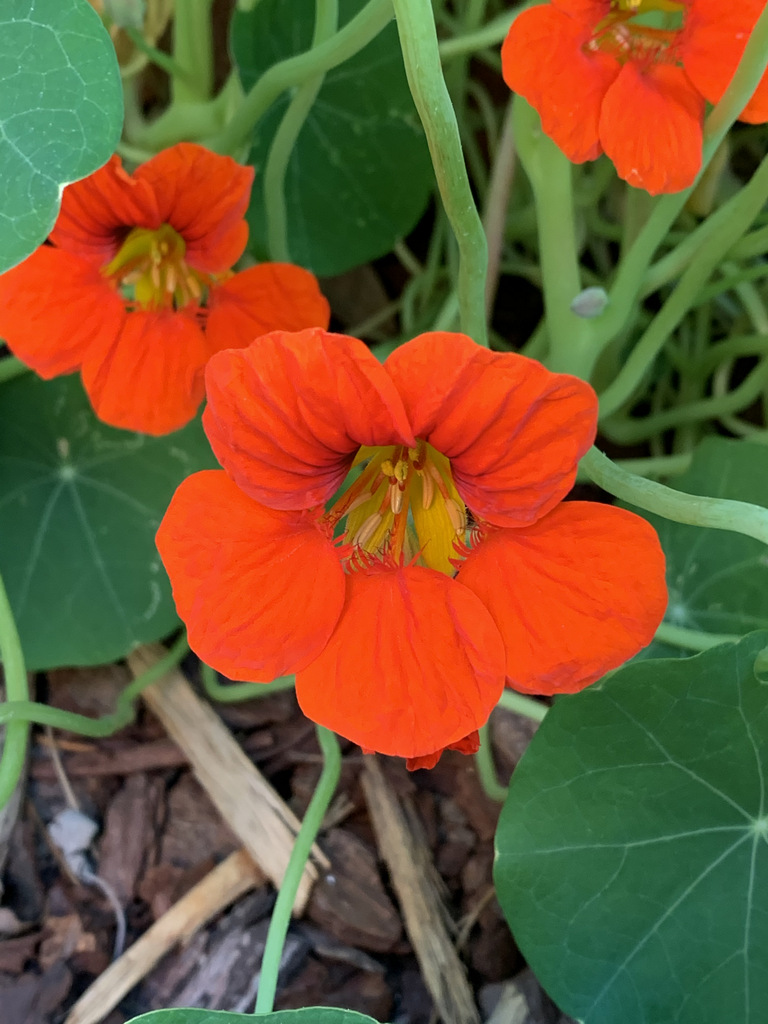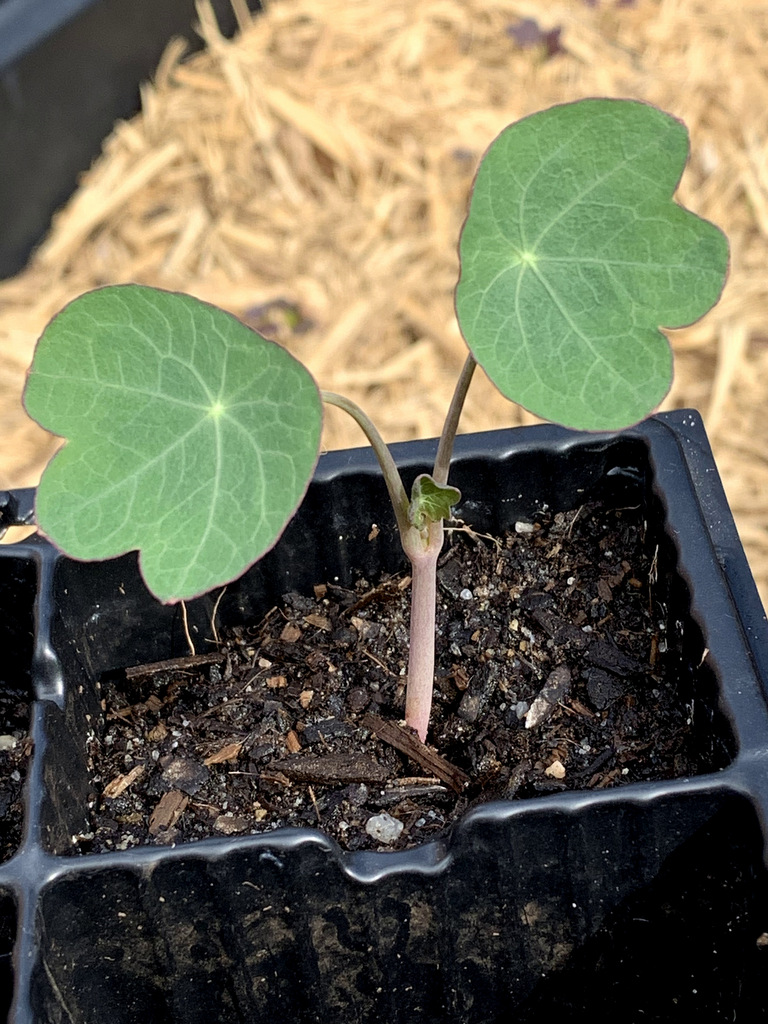They’re often grown as a sacrificial plant and make an excellent addition to an edible garden. But there’s a lot more to nasturtiums than attracting pests.

Nasturtiums – Photo © The Gourmantic Garden
As seen on Botanical Beverages: My Segment on Gardening Australia
Nasturtiums (tropaeolum majus) are annuals which come in mainly two varieties, compact bush forming and climbing/trailing. Some are semi-trailing which makes them suitable for hanging baskets, borders and rockeries. They produce edible flowers that range in colour from yellow to salmon, red, orange and black to name a few. Their leaves can be various shades of green as well as speckled and variegated. My favourite is ‘Empress Of India’, which forms a compact bush with cherry red coloured flowers against dark green leaves.
My first attempt at growing nasturtiums during spring summer of 2019 amongst the bushfires and water restrictions was dismal. The plant didn’t grow past 5 cm in height, flowered once and withered away. My second attempt during autumn / winter 2020 yielded giants that went out of control and took over the raised garden beds.
I have nasturtiums growing in various parts of the garden. Some are at the corners of the raised beds, others are planted in ground near what will be a sweet pea wall. I have one plant growing in a container under exclusion netting in order to harvest leaves, flowers and seeds before the garden pests have a feast.
GROW IT
How to Grow Nasturtiums

Nasturtium Seedlings – Photo © The Gourmantic Garden
Nasturtiums are easy to grow under the right conditions. Their seed can be sown direct or raised as seedlings. Soak the seeds in water overnight before planting as it speeds germination. For temperate climates such as Sydney, sow 15mm deep in spring or early autumn. They take 7 to 14 days to germinate when the temperatures are between 15 and 20°C.
Nasturtiums favour moist and well-drained soil and grow in either full sun or part shade. If planting more than one, space them 30-45cm apart. They take 70-80 days to reach maturity and begin to flower.
They make good companions plants to brassicas and chard. They’re a resilient plant. Some critter ate the roots of one of my seedlings and I simply put it back in soil, covered it with a plastic container and it continued to grow.
Nasturtium Plant Care
Nasturtiums are easy to look after. They can grow in poor soil provided it’s kept moist but not waterlogged. The plants can get out of control and may need a prune every now and then. Simply cut them back and they’ll grow.
Nasturtiums are often grown as sacrificial plants as they are known to attract pests and keep them away from your prized crops. Some of mine are growing near salvias, sweet peas and kohlrabi and the bugs have totally avoided them.
If you’ve grown them before, you’d know that they’re a magnet for white cabbage moths. They head straight to their large flat leaves and lay eggs usually on the underside which hatch and turn into fat, juicy green caterpillars that wreck havoc in the garden.

Cabbage Moth Eggs – Photo © The Gourmantic Garden
Unless you want a caterpillar infestation, make it part of your daily gardening ritual to check for those tiny eggs and gently brush them away with your finger.
Snails and slugs are also attracted to nasturtiums so be prepared to not to have a picture perfect plant. On the plus side, it grows prolifically and there’s often enough to share with the bugs.
Harvesting & Seed Saving

Nasturtium Seeds – Photo © The Gourmantic Garden
Nasturtium flowers can be harvested once they bloom but if you leave them on the plant, they will shrivel and die down and eventually, seeds forms. These can be collected and planted in season otherwise they self-seed and grow back year after year. Anyone else thins nasturtium seeds look like mini shrivelled brains or walnuts?
Tips for Growing Nasturtiums
- If you’re growing nasturtiums as an edible plant, sow extra seed as some pants will inevitably get damaged by pests.
- If you’re growing them under exclusion netting, making sure the fabric doesn’t come into contact with the plant as cabbage moths can still lay their eggs on it.
EAT IT
Culinary Uses of Nasturtiums
Although they attract garden pests, the whole plant is edible. The leaves have a peppery flavour and can be added to salads, desserts, rice paper rolls, made into a pesto style sauce, or used to wrap food like betel leaves. Try lining a muffin tin with the leaves and filling them to make a mini quiche.
Much like zucchini flowers, the flowers are also edible and can be stuffed with your choice of filling. Both leaves and flowers can be dehydrated, mixed with sea salt and turned into a spicy nasturtium salt. Once the seeds form, they can be picked, dried and pickled as a substitute for capers. Seeds can also be dehydrated and ground to be used as a substitute for pepper.
DRINK IT
Nasturtiums in Cocktails

Nasturtium Martini – Photo © The Gourmantic Garden
One of my favourite ways of using nasturtiums in cocktails is to use the smaller leaves as garnish and float them on top of the drink. Try adding it to Martini for an elegant cocktail. If you fancy large flowers in your drinks, you can certainly use them but I’m all for simplicity and elegance. Alternatively, the flowers can also be frozen in water to create a beautiful nasturtium ice sphere.
Nasturtiums complement a range of white spirits such as gin, vodka, rum, rhum agricole and cachaca. Aside from using nasturtiums as garnish, try muddling the leaves for a peppery note, use them in a Mojito riff with light rum or preferably rhum agricole to enhance the vegetal notes.
NASTURTIUM GROWING GUIDE AT A GLANCE
For temperate climate (Sydney, Australia)
- Sowing Season: spring, summer, early autumn
- Sowing Method: sow direct or raise seedlings
- Position: full sun or part shade
- Seed Preparation: soak in water overnight before sowing
- Soil: moist well drained soil
- Sowing Depth: 15mm
- Plant Spacing: 30-45cm apart
- Row Spacing: n/a
- Plant Height: can be climbing, bushy or trailing
- Germination: 7 to 14 days
- Time to Maturity/Harvest: 70-80 days
- Water Requirements: do not overwater
- Fertiliser Requirements: add a balanced fertiliser to soil before planting
- Companion Planting: brassicas, chard
- Ones to Avoid: none
- Succession Planting: n/a
Want to Know More?
You’ll find more information on how to grow nasturtium, which varieties to try, how to pair it with food and spirits, and how to use nasturtium in cocktails including a full recipe in my 260+ page digital book GROW YOUR OWN COCKTAIL GARDEN available now.


